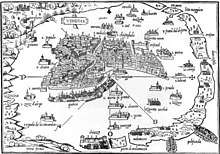Benedetto Bordone
Benedetto Bordone (1460–1531) was a manuscript editor, miniaturist and cartographer, he was born in Padua, then part of the Republic of Venice.

_ARes28207_0041.jpg)
His most famous work is the Isolario (The Book of Islands, "where we discuss about all islands of the world, with their ancient and modern names, histories, tales and way of living...") in which he describes all the islands of the known world with their folklore, myths, cultures, climates, situations, and history. Printed in Venice in 1528, the work is an example of a cartographic genre popular in Italy during the fifteenth and sixteenth centuries.[1] It is intended as an illustrated guide for sailors and attempts to include all the new transatlantic discoveries.
Isolario contains an oval depiction of the world, a type of map invented by Bordone [2] and later formalized into the equal-area elliptical Mollweide projection three centuries later. Bordone's map shows a very distorted Mondo Novo (New World), displaying only the northern regions of South America. North America, depicted as a large island, is labeled Terra del Laboratore (Land of the worker), almost certainly a reference to the slave trading in the area in those days (and hence the name Labrador).
The book also contains a record of Pizarro's conquest of Peru, the earliest known printed account of this event. Of particular interest in this work are numerous woodcut maps, twelve of which relate to America. One map displays a plan of "Temistitan" (Tenochtitlan, modern Mexico City) before its destruction by Cortez. Also of interest is a map of Ciampagu the earliest known European-printed map of Japan as an island.
Bordone is reputed to have been the father of Julius Caesar Scaliger, a classical scholar, and grandfather of Joseph Justus Scaliger, founder of the science of historical chronology.
Original maps from Bordone's Isolario are prized for their historical value.
References
- Yale University Map Department Archived June 21, 2010, at the Wayback Machine
- Columbia University photo of Bordone's map
External links
Bibliography
- Isolario (1528)
- Lilian Armstrong: Benedetto Bordon and the Illumination of Venetian Choirbooks around 1500: Patronage, Production, Competition. In: Wege zum illuminierten Buch. Herstellungsbedingungen für Buchmalerei in Mittelalter und früher Neuzeit. Wien 2014, S. 148-176, ISBN 978-3-205-79491-2, Online: https://e-book.fwf.ac.at/detail_object/o:521
- Anastasia Stouraiti, 'Talk, Script and Print: The Making of Island Books in Early Modern Venice', Historical Research vol. 86, no. 232 (2013), 207-229.
- Ludovica Radif, «Benedictus Bordo» in Compendium Auctorum Latinorum Medii Aevi II/2, 2005, p. 204.